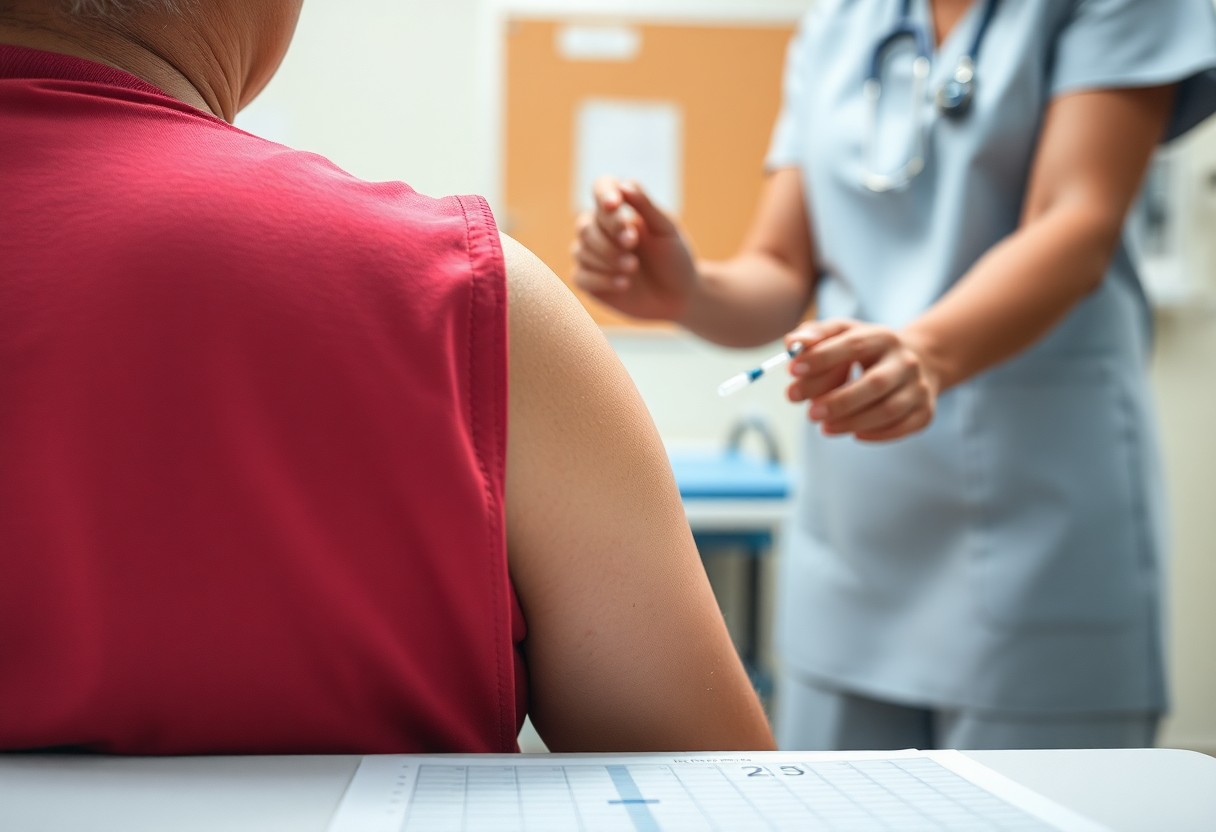It’s imperative to understand the association between certain vaccines and Shoulder Injury Related to Vaccine Administration (SIRVA). This condition can occur when vaccines are administered improperly, leading to pain and limited mobility in your shoulder. In this post, you will learn about the vaccines most frequently associated with SIRVA, including the flu vaccine and others, and what steps you can take to minimize your risk. Understanding these factors will empower you to make informed decisions about your vaccinations while ensuring a safe experience.
Understanding SIRVA
The term SIRVA, or Shoulder Injury Related to Vaccine Administration, refers to shoulder pain and dysfunction that occurs after receiving a vaccine. This condition typically affects the glenohumeral joint and surrounding tissues, leading to symptoms such as pain, limited range of motion, and discomfort that can persist for weeks or even months post-vaccination.
Definition and Symptoms
Above all, SIRVA presents with various symptoms including localized shoulder pain, weakness, and swelling. You may also experience difficulty performing daily activities due to restricted movement. If you notice these symptoms following a vaccination, it’s important to consult with a healthcare professional for appropriate evaluation and management.
Mechanism of Injury
Among the factors contributing to SIRVA are improper vaccine administration techniques, particularly injecting the vaccine too high in the shoulder. This can lead to injury of the surrounding structures, including the bursa and tendons, resulting in inflammation and pain.
A common cause of SIRVA involves the intramuscular injection being delivered into the wrong area of the shoulder, leading to direct trauma to nearby soft tissues. When the vaccine is administered too high or too laterally, it can irritate or injure the bursa, rotator cuff tendons, and even the acromion process. This inflammation can manifest as pain, swelling, and decreased mobility. Understanding these dynamics can help you take preventive measures during your vaccination to minimize the risk of developing SIRVA.
Types of Vaccines Associated with SIRVA
It is vital to understand which vaccines are most often linked to Shoulder Injury Related to Vaccine Administration (SIRVA). The following list outlines the types of vaccines commonly associated with SIRVA:
| Vaccine Type | Association with SIRVA |
|---|---|
| Influenza | Commonly reported |
| Tdap | Potential risk |
| COVID-19 | Emerging cases |
| Pneumococcal | Low association |
| Hepatitis B | Occasional reports |
Knowing the types of vaccines involved can help you make informed decisions about your vaccination and its potential effects on your body.
Influenza Vaccine
Across various studies, the Influenza vaccine is frequently reported as one of the vaccines most associated with SIRVA. This is primarily due to its widespread administration during flu season. Individuals receiving this vaccine should ensure proper injection technique to minimize the risk of shoulder injury.
COVID-19 Vaccines
Across the globe, COVID-19 vaccines have been subject to scrutiny, with some cases of SIRVA reported following their administration. As these vaccines are rolled out extensively, understanding the potential risks becomes vital for your health.
In addition, it’s important to note that while reports of SIRVA related to COVID-19 vaccines are increasing, the overall incidence remains low compared to vaccinations in general. You should be aware that proper administration technique can significantly reduce your risk. Should you experience shoulder pain post-vaccination, consult a healthcare professional to evaluate your symptoms and receive appropriate care. Being informed is key to your health and safety.

Risk Factors for Developing SIRVA
If you want to understand the risk factors for developing SIRVA, consider the following aspects that can increase your chances:
- Improper injection site location
- Incorrect injection technique
- Pre-existing shoulder conditions
- Age factors
Perceiving these risk factors can help you make informed decisions about vaccination and minimize potential complications.
Injection Technique
At the time of your vaccination, the injection technique plays a significant role in the likelihood of developing SIRVA. A well-trained healthcare provider should ensure that the needle is properly positioned in the deltoid muscle to reduce the risk of injury to surrounding tissues.
Patient Characteristics
Among the various factors, your specific characteristics can also affect the risk of SIRVA. Individual attributes such as age, gender, and physical condition can influence how your body responds to the vaccine.
Plus, it’s important to note that certain factors may put you at greater risk, including being older, female, and having a history of shoulder pain or conditions like frozen shoulder. Your body mass index (BMI) could also play a role; higher BMI can complicate injection site localization. Understanding these factors enables you to discuss them openly with your healthcare provider to ensure safer vaccination practices.
Prevention Strategies
For reducing the risk of SIRVA, implementing effective prevention strategies is imperative. This includes adhering to proper injection practices and enhancing patient education. By ensuring these strategies are a priority, you can help mitigate the chances of adverse reactions while receiving vaccinations.
Proper Injection Practices
One of the most effective ways to prevent SIRVA is through proper injection techniques. Healthcare providers should always locate the correct anatomical sites and use appropriate needle sizes to ensure that injections are administered in the right muscles, such as the deltoid, while avoiding surrounding tissues.
Patient Education
About enhancing awareness, patients should be fully informed about the vaccination process and how to recognize potential symptoms of SIRVA. Education can empower you to communicate any discomfort or complications to your healthcare provider promptly.
For instance, educating you about the signs of SIRVA can lead to earlier interventions. You should be aware that symptoms may include persistent pain, swelling, or limited range of motion in the arm after a vaccination. By discussing these outcomes, you can illustrate the importance of seeking medical attention if they arise, ensuring you receive timely care while promoting a better understanding of your own health.
Treatment Options for SIRVA
To manage SIRVA, treatment options can vary based on the severity and duration of your symptoms. Initial approaches often involve pain relief strategies, including over-the-counter medications such as nonsteroidal anti-inflammatory drugs (NSAIDs), which can help alleviate discomfort. In more persistent cases, your healthcare provider may recommend corticosteroid injections to reduce inflammation and improve mobility.
Medical Management
Any ongoing pain or limited motion due to SIRVA may require medical management, which can include physical therapy and medication. Your healthcare provider may prescribe stronger pain relief options or anti-inflammatory medications to help manage symptoms effectively. It is vital to follow their guidance for optimal recovery.
Rehabilitation Approaches
Any rehabilitation approaches for SIRVA focus on restoring your shoulder function and alleviating pain through targeted exercises and therapies. A physical therapist can design a personalized program that may include stretching, strengthening, and manual therapy techniques tailored to your specific needs.
Consequently, actively engaging in rehabilitation can significantly improve your shoulder function and reduce pain associated with SIRVA. Therapeutic exercises can enhance flexibility and strength, facilitating a faster and more effective recovery. Working closely with a healthcare professional ensures you receive the most appropriate and safe treatment, ultimately helping you return to your everyday activities with confidence.
Research and Future Directions
Unlike previous studies that focused primarily on adverse reactions to vaccines, current research aims to understand the mechanisms leading to SIRVA (Shoulder Injury Related to Vaccine Administration). Investigating the interplay of injection techniques, anatomical variations, and patient factors will enhance safety protocols and reduce the incidence of this condition. Future efforts will be directed towards developing comprehensive guidelines and educational resources for healthcare providers to ensure optimal vaccine administration, minimizing risks for patients like you.
Studies on Vaccine Safety
To improve vaccine safety, ongoing studies are assessing the prevalence and risk factors associated with SIRVA. These investigations utilize large databases and patient-reported outcomes to identify any patterns, allowing for better understanding and prevention strategies. Your involvement in reporting any adverse effects can significantly contribute to this research and enhance overall vaccine safety.
Innovations in Injection Techniques
An evolving focus on innovation in injection techniques aims to optimize vaccine administration methods, reducing the likelihood of injury. Recent advances include the use of needle-free devices and modified injection angles, which can significantly improve safety outcomes.
Future innovations in injection techniques are set to reshape vaccine administration. Needle-free delivery systems are emerging, promising to eliminate the risk of SIRVA. Additionally, incorporating advanced training programs for healthcare providers on proper techniques can help ensure that vaccines are administered at the correct angle and depth, reducing the likelihood of shoulder injuries. By embracing these innovations, you can help foster a safer vaccination environment and mitigate risks associated with improper administration.
To wrap up
On the whole, it’s important to understand that any vaccine administered intramuscularly can potentially result in Shoulder Injury Related to Vaccine Administration (SIRVA) if not given correctly. However, vaccines like the influenza and COVID-19 vaccines are commonly associated with this issue, primarily due to the locations often chosen for injection. As you prepare for your vaccinations, ensuring proper administration techniques and understanding the risk factors can aid in minimizing the occurrence of SIRVA and promote a smoother vaccination experience.



















